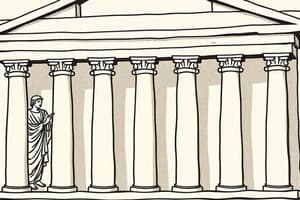Podcast
Questions and Answers
What is the Law of the Twelve Tables?
What is the Law of the Twelve Tables?
- A contract format in question and answer
- A legal action demanding the return of stolen property
- A set of guidelines passed down through precedent
- The first legal text of ancient Rome (correct)
What is stipulatio in Roman law?
What is stipulatio in Roman law?
- A system of procedure for Roman law
- A private person who acts as a judge in Roman law
- A contract format in question and answer (correct)
- A legal action demanding the return of stolen property
What is rei vindicatio in Roman law?
What is rei vindicatio in Roman law?
- A legal action demanding the return of stolen property (correct)
- A system of procedure for Roman law
- A contract format in question and answer
- A private person who acts as a judge in Roman law
What is the mos maiorum in Roman law?
What is the mos maiorum in Roman law?
What is the basis of legal practice in the Eastern Roman Empire throughout its so-called Byzantine history?
What is the basis of legal practice in the Eastern Roman Empire throughout its so-called Byzantine history?
When did the rediscovered Roman law dominate the legal practice of many European countries?
When did the rediscovered Roman law dominate the legal practice of many European countries?
What happened to the private judge system in Roman judicial procedure?
What happened to the private judge system in Roman judicial procedure?
What is ius civile Quiritium in Roman law?
What is ius civile Quiritium in Roman law?
What is the legacy of Roman law?
What is the legacy of Roman law?
Flashcards
Twelve Tables
Twelve Tables
The first written Roman legal code, established in the mid-5th century BC.
Roman Civil Law
Roman Civil Law
Roman law regarding citizens, distinct from law for non-citizens.
Stipulatio
Stipulatio
The fundamental contract type in Roman law, which used question-and-answer format.
Rei Vindicatio
Rei Vindicatio
Signup and view all the flashcards
Ius Commune
Ius Commune
Signup and view all the flashcards
Corpus Juris Civilis
Corpus Juris Civilis
Signup and view all the flashcards
Legal Status (Status)
Legal Status (Status)
Signup and view all the flashcards
Roman Law Influence
Roman Law Influence
Signup and view all the flashcards
Mos Maiorum
Mos Maiorum
Signup and view all the flashcards
Study Notes
Legal System of Ancient Rome (c. 449 BC – AD 529)
-
Roman law is the legal system of ancient Rome, including the legal developments spanning over a thousand years of jurisprudence, from the Twelve Tables (c. 449 BC), to the Corpus Juris Civilis (AD 529).
-
Roman law served as a basis for legal practice throughout Western continental Europe, as well as in most former colonies of these European nations, including Latin America, and also in Ethiopia.
-
Roman law also denoted the legal system applied in most of Western Europe until the end of the 18th century.
-
Private law comprised the Roman civil law (ius civile Quiritium) that applied only to Roman citizens, and was bonded to religion before the Twelve Tables (754–449 BC).
-
The first legal text is the Law of the Twelve Tables, dating from the mid-fifth century BC.
-
The adaptation of law to new needs was given over to juridical practice, to magistrates, and especially to the praetors.
-
By the middle of the 3rd century, the conditions for the flourishing of a refined legal culture had become less favorable.
-
The Roman Republic's constitution or mos maiorum ("custom of the ancestors") was an unwritten set of guidelines and principles passed down mainly through precedent.
-
Stipulatio was the basic form of contract in Roman law. It was made in the format of question and answer.
-
Rei vindicatio is a legal action by which the plaintiff demands that the defendant return a thing that belongs to the plaintiff.
-
A person's abilities and duties within the Roman legal system depended on their legal status (status).
-
The individual could have been a Roman citizen (status civitatis).The Legacy of Roman Law: From Litigation to Legal Practice
-
Roman law can be divided into three systems of procedure: legis actiones, the formulary system, and cognitio extra ordinem.
-
During the Roman Republic, the judge was usually a private person (iudex privatus) who could consult a jurist about the technical aspects of the case but was not bound by their response.
-
Later on, with the bureaucratization of Roman judicial procedure, the private judge system disappeared, and was substituted by the so-called "extra ordinem" procedure.
-
The codes of Justinian, particularly the Corpus Juris Civilis, continued to be the basis of legal practice in the Eastern Roman Empire throughout its so-called Byzantine history.
-
Roman law, or at least some provisions borrowed from it, began to be reintroduced into legal practice, centuries after the end of the Roman empire.
-
By the middle of the 16th century, the rediscovered Roman law dominated the legal practice of many European countries.
-
Only England and the Nordic countries did not take part in the wholesale reception of Roman law.
-
The practical application of Roman law, and the era of the European Ius Commune, came to an end when national codifications were made.
-
Today, Roman law is no longer applied in legal practice, even though the legal systems of some countries are still based on the old jus commune.
-
However, even where the legal practice is based on a code, many rules deriving from Roman law apply.
-
For this reason, knowledge of the Roman law is indispensable to understand the legal systems of today.
-
As steps towards a unification of the private law in the member states of the European Union are being taken, the old jus commune is seen by many as a model.
Studying That Suits You
Use AI to generate personalized quizzes and flashcards to suit your learning preferences.




